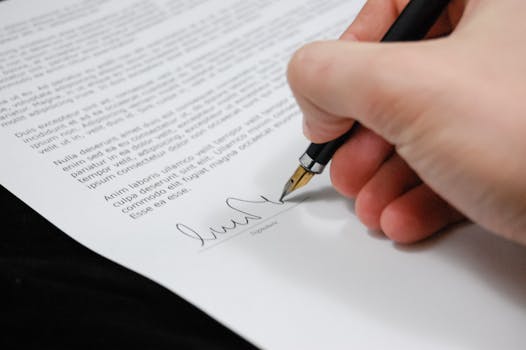Introduction
Cracking the code of property transactions can often feel like trying to solve a complex puzzle. One of the most frequently asked questions in this domain is, “how long after the transfer deed to completion?” Well, buckle up property buyers and sellers, because we’re about to embark on a comprehensive guide that will illuminate the timelines and expectations involved in this process.
In this article, we will demystify the conveyancing process, shed light on the crucial role of the transfer deed, provide a detailed timeline from transfer deed to completion, and guide you through what to expect during the completion stage. We will also explore how partnering with a professional conveyancing and survey service like My Conveyancing Specialist can make the process more transparent, efficient, and tailored to your needs, saving you both time and money.
Understanding the conveyancing process and its timelines is not just about satisfying curiosity; it’s about empowering you to make informed decisions that could significantly impact your home ownership journey. So, whether you’re a first-time buyer or a seasoned property trader, this guide promises to deliver insights that can help streamline your property transactions and enhance your understanding of the process. Let’s dive in!
Understanding the Conveyancing Process
What is Conveyancing?
Conveyancing is a fundamental legal process that occurs when ownership of a property is transferred from a seller to a buyer. It’s the heartbeat of every property transaction, providing the legal framework that safeguards the interests of both parties involved. From the moment an accepted offer is made on a property to the final signatures on all associated contracts, the conveyancing process keeps the transaction moving smoothly and securely.
The Role of a Conveyancer
A conveyancer, who can be a property solicitor or licensed conveyancer, is the mastermind guiding you through the labyrinth of the conveyancing process. Their role is to handle the legal aspects of the transaction and ensure that your interests are well protected. They advise on contracts, conduct necessary searches to uncover potential issues with the property, handle payments, and liaise with other parties involved in the transaction. Their expertise and guidance are invaluable in navigating the complexities of property law, ensuring you avoid potential pitfalls and make informed decisions.
Key Stages in the Conveyancing Process
The conveyancing process is divided into several stages, each with its unique tasks and responsibilities.
Pre-Contract Stage: This initial stage sees your conveyancer reviewing the contract pack, carrying out necessary searches (including local authority, environmental, and water and drainage searches) and raising pre-contract enquiries. It’s also during this time that the contracts, which detail crucial information such as price, boundaries, planning restrictions, and completion date, are drafted. If needed, this stage also allows for negotiations regarding the completion date, deposit amount, and other contract conditions.
Exchange of Contracts: At this stage, the deal becomes legally binding. The buyer and seller’s solicitors exchange signed contracts, and the buyer usually pays a deposit, typically 10% of the purchase price. After the contracts are exchanged, both parties are committed to finalize the transaction, with penalties applicable for any breaches.
Completion and Post-Completion: The completion stage is the grand finale of the conveyancing process. The seller vacates the property, and the buyer’s conveyancer sends the sale proceeds to the seller’s conveyancer. After completion, the post-completion stage kicks in, where the conveyancer settles any remaining administrative tasks such as paying the Stamp Duty and registering the new owner with the Land Registry.
Understanding each stage of the conveyancing process is key to ensuring a smooth and successful property transaction. Remember, a well-guided journey through the conveyancing process not only secures your property transaction but also sets the stage for a stress-free transition into your new home.
The Importance of the Transfer Deed
Owning a property is synonymous with holding the key to your own castle. But in the world of conveyancing, the true key to your castle is the transfer deed. This legal instrument wields the power to unlock the final stage of your property transaction – completion. Without it, your journey to homeownership remains incomplete.
What is a Transfer Deed?
A transfer deed is a vital legal document that plays a crucial role in transferring ownership of a property from the seller to the buyer. This document contains detailed information about the property, including the names of the buyer and seller, the agreed purchase price, and the property’s exact description. It’s the final piece of the puzzle that signifies you are the rightful owner of your dream home.
The Role of the Transfer Deed in the Conveyancing Process
In the labyrinth of the conveyancing process, the transfer deed is your map. It guides you from the acceptance of your offer, through the exchange of contracts, and culminates in the completion stage.
Once the offer is accepted, the seller’s solicitor obtains the property’s title deeds and prepares a draft contract, which is forwarded to the buyer’s solicitor for approval. This is where the transfer deed comes into play. The buyer’s solicitor reviews the draft contract and the transfer deed, carrying out various searches to ensure there are no hidden surprises that could negatively impact the property.
The transfer deed is then signed by both parties, witnessed, and exchanged along with the agreed deposit, usually 10% of the purchase price. After the exchange of contracts, the transfer deed becomes a legally binding agreement. If either party reneges on the agreement after this point, they could be liable for compensation.
Common Issues with Transfer Deeds
While the transfer deed is a powerful tool that helps secure your property ownership, it’s not without potential pitfalls. Common issues can arise if details on the deed are incorrect or if there are unresolved claims on the property.
Incorrect details can range from misspelled names to incorrect property descriptions. These errors, while seemingly small, can lead to significant delays in the conveyancing process.
Unresolved claims or charges on the property, such as an existing mortgage or a lien, can also pose significant problems. If these are not settled before the completion stage, they could prevent the successful transfer of ownership.
In addition, if the property is still under a mortgage, the lender’s consent is required for the transfer to proceed. Without this, complications can arise, leading to delays or even a breakdown of the transaction.
Navigating these potential issues can be daunting, but with a professional conveyancing service like My Conveyancing Specialist, you can rest assured that your property transaction will be handled with efficiency, transparency, and the utmost professionalism.
Timeline from Transfer Deed to Completion
So, how long does it typically take from transfer deed to completion? Let’s unwrap the mystery.
Typical Timeline for a Straightforward Transaction
In a perfect world, where everything runs like clockwork, a straightforward property transaction will generally take between 14-16 weeks. This timeline begins from the moment you instruct your conveyancer and spans through all the stages of the conveyancing process including the drafting and signing of the transfer deed, which contains the details of the property and dictates the transfer of ownership.
However, it’s important to remember that this timeline is not set in stone. Like a tailor-made suit, every property transaction is unique, and varying factors can influence the timeline.
Factors that Can Affect the Timeline
A multitude of factors can extend the timeline from the transfer deed to completion. These complications can be as unpredictable as the weather and are often outside of your control. Some of these factors include:
- A long property chain: If your completion depends on a long line of transactions all with varying timescales, delays can occur.
- Property in probate: If there is a property in probate within your chain, extra time may be needed.
- Issues with searches or land registration: Any discrepancies or issues with the official registration of the land can cause delays.
- Incorrect information on mortgage applications: For you or anyone in your chain.
- Issues with planning permission: If there are unresolved issues with planning permission for the property, this could slow down the process.
These are just a few examples, and the reality is that the conveyancing process often involves navigating through unforeseen obstacles. But don’t fret – remember, you’re not alone in this journey. A reliable conveyancing service will communicate with you throughout the process, doing their utmost to keep your transaction on track.
How to Speed Up the Process
Even though some factors are out of your hands, there are proactive steps you can take to expedite the process:
- Choose your conveyancer wisely: A proactive and experienced conveyancer can make a world of difference.
- Be prompt with paperwork: Send all necessary documents to your conveyancer as soon as they are requested.
- Respond quickly: Timely responses to your conveyancer’s questions can prevent delays.
- Be ready: If you’re a cash buyer, the exchange and completion can be done on the same day.
In conclusion, while the timeline from transfer deed to completion can vary, being proactive and working with a professional conveyancing service can help ensure a smooth and timely transaction.
The Completion Stage: What to Expect
As we journey through the conveyancing process, the completion stage is the final act in this real estate drama. It’s the moment when the curtain rises, and the audience (or rather, the buyer) sees their new property legally and officially become theirs. But what exactly transpires on this all-important day, and what responsibilities do the parties involved have once it’s all over?
What Happens on the Day of Completion?
The day of completion is the grand finale of the property purchase process. It is on this day that the purchase monies, made up of the buyer’s own funds and any mortgage amount, are transferred to the seller’s solicitor. Once this transfer occurs, the transaction is officially completed, and the seller is typically required to vacate the property by 1pm. At this point, ownership transfers to the buyer.
The primary cause of delays on this day is usually the transfer of monies. This is particularly true if a mortgage is involved, as the funds must be sent by the lender to the buyer’s solicitor or conveyancer, who then passes them on to the seller’s legal company. If all parties involved are prompt and efficient, the completion can usually occur by 12 noon.
However, should the seller’s legal representative not receive the funds by 3pm, completion may not occur until the following day – though this is a rare occurrence. Ensuring that all monies required to complete — including stamp duty and any agents’ fees plus VAT — are correctly calculated can also prevent delays.
Post-Completion Tasks and Responsibilities
Once the completion stage is over, the buyer and seller can finally breathe a sigh of relief. But while the main hurdles have been passed, there are still some post-completion tasks and responsibilities to handle.
For the buyer, the completion is mainly about physically moving house. They will collect the keys from the selling agent and begin to move in. They will also need to check that all fixtures and fittings are present as agreed in the contract of sale and inform their agent and/or solicitor if anything is out of order. They will also need to change the locks, notify utility companies of new ownership, and inform all relevant contacts of their change of address.
Meanwhile, the buyer’s solicitor will be busy with a few more tasks. They will have to transfer the deposit to the seller’s solicitor, register the title deed of ownership with the Land Registry, and submit the Stamp Duty Land Tax Return. They will also pay the Stamp Duty Land Tax due to HMRC, and send the buyer the Title Information Document, which is a summary of information the Land Registry holds.
On the other hand, the seller will need to take final meter readings and vacate the property, handing a set of keys to the estate agent if they have not done so already. The seller’s solicitor will redeem any mortgage on the property, pay the estate agent’s bill, and settle their own bill. Finally, they will hand over the remaining balance to the seller.
In conclusion, while the completion stage marks the end of the conveyancing process, there are still some vital tasks to be accomplished to ensure a smooth transition of ownership. By understanding these responsibilities, both buyers and sellers can better navigate this final stage and move towards a successful conclusion of their property transaction.
How My Conveyancing Specialist Can Help
While the conveyancing process can be complex, there are experts available to guide you through each step, ensure all requirements are met, and help you achieve a successful property transaction. One such expert is My Conveyancing Specialist, a trusted name in the property industry known for their efficient, professional, and customer-focused services.
Tailored and Transparent Conveyancing Services
My Conveyancing Specialist recognises that every property transaction is unique. To cater to individual needs, they offer bespoke services that are meticulously tailored to your specific situation. Their handpicked property lawyers are devoted to your case, ensuring comprehensive coverage, regardless of the complexities involved.
Transparency is also a defining feature of their service. They provide crystal-clear costs upfront, with a ‘No Move, No Fee’ guarantee. This means you only pay for legal services once your sale is complete, eliminating unexpected costs and ensuring you can confidently budget for your move.
Saving Time and Money with Efficient Processes
Understanding the time-sensitive nature of property transactions, My Conveyancing Specialist prioritises efficiency. Their network of experienced online conveyancing solicitors is committed to expediting the process, reducing stress, and ensuring transactions progress as smoothly as possible. This optimised process not only ensures a timely completion but also redirects savings to you, their valued client.
They also offer a free online conveyancing quote that takes less than 30 seconds to complete, demonstrating their commitment to saving you time, money, and stress.
Commitment to Customer Satisfaction
At My Conveyancing Specialist, customer satisfaction is at the heart of their services. From conducting extensive property searches to managing contracts and overseeing financial transfers, their team of licensed professionals handles each detail with due diligence to ensure a stress-free experience for you.
Their commitment to providing prompt, reliable, and courteous service has earned them glowing testimonials from numerous satisfied clients. This dedication to customer satisfaction not only gets the job done, but it also ensures that your property transaction journey with My Conveyancing Specialist is a positive, rewarding experience.
In conclusion, with My Conveyancing Specialist, your property transaction is more than just a process—it’s a carefully managed journey designed to save you time and money while ensuring a smooth, stress-free, and successful completion.
Conclusion
Navigating the complexities of conveyancing and the journey from transfer deed to completion can seem daunting. Yet, armed with the knowledge of what to expect, understanding the timelines involved, and appreciating the critical role of each stage, you’re well-positioned to tackle the process head-on.
The transfer deed, a crucial component in any property transaction, sets the stage for the completion phase. Yet, the time taken between these two stages can vary, influenced by various factors like the complexity of the transaction, responsiveness of the parties involved, and the efficiency of your conveyancer. A straightforward transaction can complete in a matter of weeks, while others may extend over months.
Yet, remember this: while the conveyancing process is often seen as a hurdle, it’s a necessary one. It’s designed to protect all parties involved, ensuring that all legalities are addressed, and the property transaction is legally sound and valid.
Choosing a professional conveyancing service like My Conveyancing Specialist can make all the difference in your property transaction journey. With their tailored and transparent services, you’re not just getting a conveyancer – you’re partnering with a team committed to guiding you through each stage of the process. From the moment the transfer deed is drafted till the day of completion, My Conveyancing Specialist is there to ensure all runs smoothly, potentially saving you time, money, and unnecessary stress.
In the ever-evolving world of property transactions, My Conveyancing Specialist stays committed to customer satisfaction, placing your needs at the forefront of their services. Remember, your property transaction doesn’t have to be a daunting task. With the right guidance and expert service, it can be a rewarding experience that leads you to the doorstep of your new property sooner than you think.
As we wrap up this comprehensive guide, we trust that you’re now better equipped to handle your upcoming property transaction. And remember, when it comes to the journey from transfer deed to completion, My Conveyancing Specialist is ready to walk this path with you, every step of the way.



